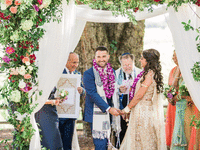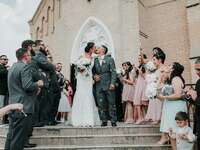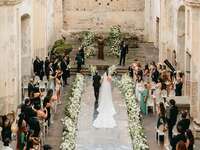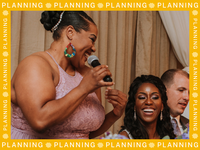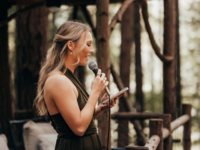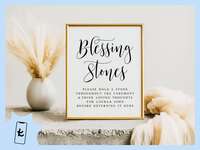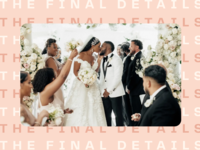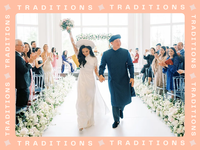Everything You Need to Know About Planning a Quaker Wedding

If you've felt the urge to skip all the fanfare of a wedding and just tie the knot yourselves, well, you can! In some states, at least. Quaker weddings are self-uniting wedding ceremonies that require two witnesses—no officiant needed. While rooted in the Quaker religion and its emphasis on the divine, simplicity, equality and community, Quaker weddings have become more popular among those not affiliated with the religion. Many couples find themselves drawn to its spiritual elements and how it allows them to create a meaningful ceremony that fits their own beliefs. So, how do Quaker weddings work? We spoke with two wedding experts who gave all the details.
In this article:
What Is a Quaker Wedding?
So, just what is a Quaker marriage? Quaker weddings are self-uniting ceremonies without a wedding officiant—you only need the signatures of two witnesses to say "I do." They're legal in just a handful of states: Pennsylvania, California, Colorado, Maine, Nevada, Wisconsin, Illinois and Kansas, plus Washington, DC.
"Within the ceremony, you're stating that you're committing yourselves both spiritually and legally to each other instead of having an officiant state it," explains photographer Carly D'Angelo of Wild North Weddings based in Greensburg, Pennsylvania.
This ceremony stems from the Quaker religion that largely settled in the Pennsylvania region under the direction of William Penn. Members of the religion often referred to themselves as Friends and thus named themselves the Religious Society of Friends. "They believe that every person has a direct connection to God, and thus they don't require any religious figure to translate for them," says Merida Alexander, events planner at Events by Merida in North Wales, Pennsylvania.
But you don't have to be a Quaker to have a Quaker marriage ceremony. None of the couples in the self-uniting ceremonies D'Angelo has photographed since she started specializing in elopements five years ago have been Quakers. "Couples are more often choosing it for the convenience and also to keep things personal," she says. "They find meaning behind committing themselves to each other versus someone else declaring their marriage is valid."
Quaker Wedding Traditions
There are tons of wedding traditions around the world. What separates Quaker wedding traditions from others is that they draw from Quakers' emphasis on simplicity and equality. From the ceremony to the reception, a Quaker wedding is focused less on detail and hierarchy and more on the people and meaning involved. Look no further than its key traditions.
Clearness Committee
Before the ceremony, Quakers typically use a Clearness Committee in the local community to get clarity on their partnership. The process involves thoughtful questions and careful listening, addressing potential difficulties, and discussing the spiritual nature of marriage. However, more modern or non-affiliate Quakers may skip this step altogether or have a more informal version.
No Officiant
The biggest hallmark of a Quaker-style wedding ceremony is the aforementioned lack of officiant. This is based on the tenet that only God can join a couple in marriage—Quakers believe you don't need a church official to tie the knot. There traditionally aren't wedding parties either. However, Alexander says that her clients doing a Quaker wedding tend to have bridesmaids and groomsmen anyway.
The Quaker Marriage Certificate
Alexander calls the Quaker marriage certificate "a beautifully designed document." It includes the couples' vows and is signed by the couple and all wedding attendees. Typically, a designated person will read the certificate aloud during the period of silence.
Period of Silence
The wedding is held as a Meeting of Worship, in which everyone sits in silent meditation until the couple decides to speak. They announce their intentions to one another, but Alexander says they tend not to refer to them as traditional wedding vows—"promises might be more accurate."
Traditionally, couples don't exchange rings, but you'll still see this in more modern ceremonies. Sometimes, the couple will also perform a unity ceremony, like a handfasting or tree watering, D'Angelo says—she's even seen a couple make a PB&J sandwich together. They may also include spiritual or cultural traditions from their own backgrounds to add a personal touch.
Afterward, the period of silence continues, and anyone who feels moved to do so can make a statement as well, whether they want to give Quaker wedding blessings or a Quaker wedding reading. This means the ceremonies can go on for quite some time. At one wedding Alexander planned, a friend was assigned to "wrap it up" if someone went on for too long.
Low-Key Receptions
Receptions aren't a formal part of a Quaker wedding, but they are typically warm celebrations centered around the community. In keeping with the preference for simplicity and no hierarchy, Quaker wedding receptions forgo flashiness. Think minimal decor in neutral tones, potluck meals instead of fancy catering, mocktails instead of alcohol, and environmental-friendly details like reusable plates and informal seating so that everyone can mix and mingle. "But receptions are frequently as varied as any other couple," Anderson says. "The differences are predominantly ceremonial."



How to Plan a Quaker Wedding Ceremony
Different types of wedding ceremonies require different types of planning methods, including Quaker wedding ceremonies. For example, a Quaker wedding dress code typically involves modest, subtle and simple clothing, which you may want to call out for guests in your wedding invites.
D'Angelo says she's had couples perform a Quaker marriage ceremony for both elopements and large weddings, so a lot of preparation for a wedding like this will depend on the size of the wedding you're planning. Regardless, here's what you should know.
Check Legalities
First things first, make sure your state allows self-uniting ceremonies. If it doesn't, Alexander recommends having a friend get ordained (but make sure that church is in good standing with the state) so they can sign the marriage certificate. You could also plan your nuptials in a state that does allow self-uniting ceremonies.
Pick a Venue
As with any other wedding, you'll want to determine when and where your Quaker wedding will take place. Since many Quakers are deeply connected to nature and one another, look for natural settings, like a forest or beach, or community spaces, like a barn or library. Ask yourself if it reflects simplicity and is conducive to the period of silence.
Find Vendors
Because Quaker wedding ceremonies are simpler, you won't need as many vendors as you would for other weddings. You won't need an officiant, for one, or a musician since Quaker weddings are typically silent (although you can still bring one in if you prefer). But you might want to hire a stationery artist for your marriage certificate, a photographer to capture all the moments, and a rental company for seating if you're tying the knot outdoors. You can find a variety of options within your budget at The Knot Vendor Marketplace.
Write Your Marriage Certificate and Vows
Your personal wedding vows or intentions can be printed, written on notebook paper or in small vow books you can keep forever, D'Angelo says. But regardless of where you put them down, remember: your Quaker wedding vows will also need to go on the marriage certificate. That should also include your full names, wedding date and location, statement of your commitment and places for signatures.
Design Your Ceremony
You don't need to follow the typical wedding ceremony order. The beauty of a Quaker wedding ceremony is that you can craft it around your own desires. "Have a conversation together to discuss if there are any personal or cultural touches you'd like to include that would be meaningful to either of you," D'Angelo advises. You'll want to determine when in the ceremony you want to include those, as well as whether you want to incorporate a unity ceremony, ring exchange or any readings. If you're asking a friend to do a reading, she suggests making sure they're printed out and not just saved on your phone.
"What has worked well in the past is that friends or family members will come up to the front to 'officiate' different parts of the wedding so people will know when to come up and do readings, exchanging of rings, etc.," Alexander says. "In the traditional Quaker ceremony, the couple does all of that. That can be a lot of pressure for a couple that's unaccustomed to public speaking, so having someone else there to help things along is something many couples opt for."
Write a Ceremony Script
A Quaker wedding ceremony script is different from vows or intentions—think of it as the part the officiant would say if there was an officiant. It's different from a Christian wedding ceremony script, but you can infuse elements of it if you identify with that religion. D'Angelo says the script should include an opening welcome statement, lines for the ring exchange and unity ceremony if you're doing them, and a final pronouncement of marriage.
Create a Wedding Program
It's likely that some of your guests haven't attended a Quaker wedding before. Now that you have your ceremony mapped out, you'll want to create a Quaker wedding ceremony program that walks them through what to expect.
In the welcome statement, include a brief explanation of a Quaker ceremony. Follow that up with a loose structure of events, any included readings, an explanation of the marriage certificate, and, if you want, a note of thanks. Keep the design minimal, organic and neutral.

